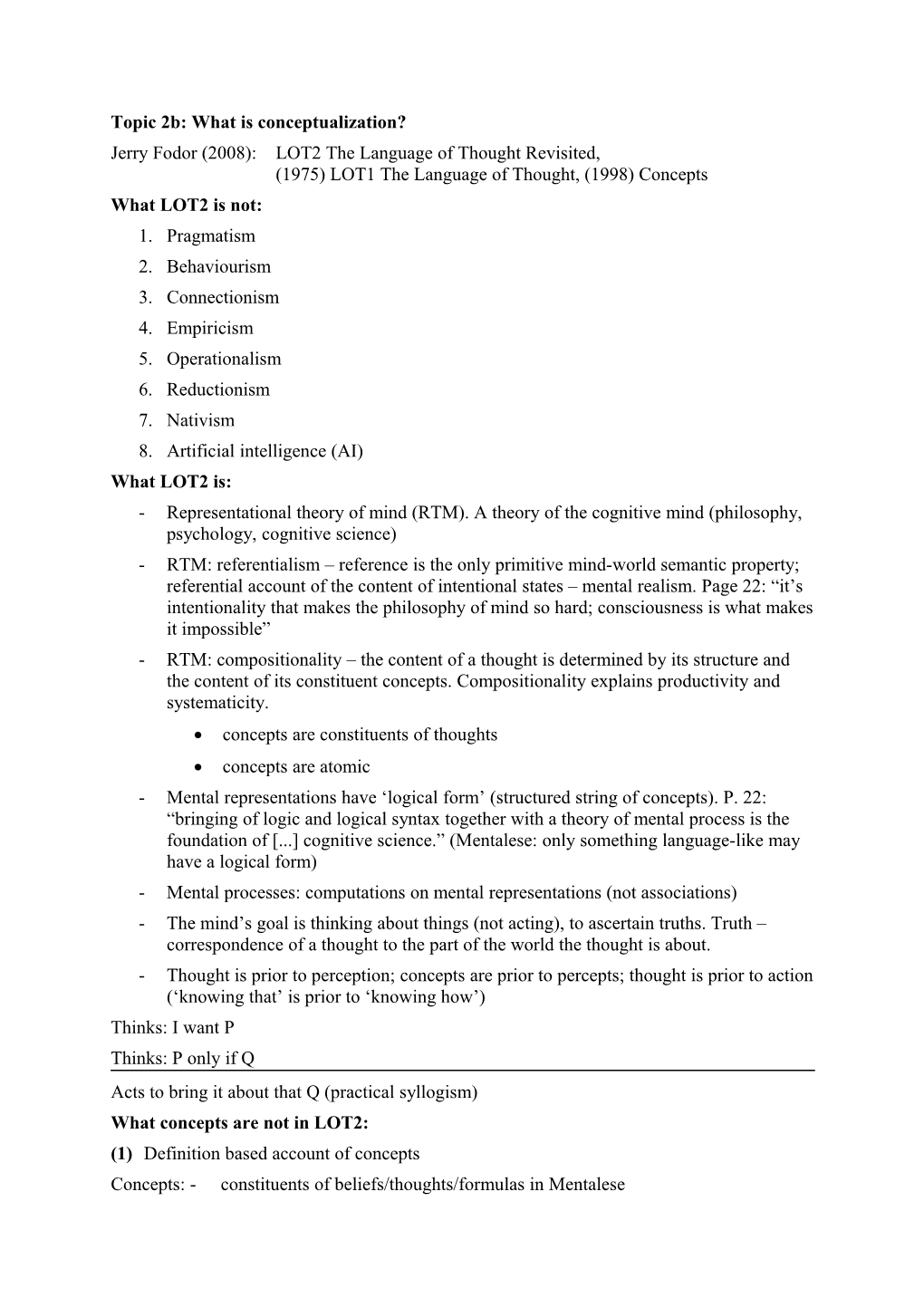Topic 2b: What is conceptualization?
Jerry Fodor (2008): LOT2 The Language of Thought Revisited,
(1975) LOT1 The Language of Thought, (1998) Concepts
What LOT2 is not:
- Pragmatism
- Behaviourism
- Connectionism
- Empiricism
- Operationalism
- Reductionism
- Nativism
- Artificial intelligence (AI)
What LOT2 is:
- Representational theory of mind (RTM). A theory of the cognitive mind (philosophy, psychology, cognitive science)
- RTM: referentialism – reference is the only primitive mind-world semantic property; referential account of the content of intentional states – mental realism. Page 22: “it’s intentionality that makes the philosophy of mind so hard; consciousness is what makes it impossible”
- RTM: compositionality – the content of a thought is determined by its structure and the content of its constituent concepts. Compositionality explains productivity and systematicity.
- concepts are constituents of thoughts
- concepts are atomic
- Mental representations have ‘logical form’ (structured string of concepts). P. 22: “bringing of logic and logical syntax together with a theory of mental process is the foundation of [...] cognitive science.” (Mentalese: only something language-like may have a logical form)
- Mental processes: computations on mental representations (not associations)
- The mind’s goal is thinking about things (not acting), to ascertain truths. Truth – correspondence of a thought to the part of the world the thought is about.
- Thought is prior to perception; concepts are prior to percepts; thought is prior to action (‘knowing that’ is prior to ‘knowing how’)
Thinks: I want P
Thinks: P only if Q
Acts to bring it about that Q (practical syllogism)
What concepts are not in LOT2:
(1) Definition based account of concepts
Concepts: - constituents of beliefs/thoughts/formulas in Mentalese
-constituted by definitions (defining inferences)
BACHELOR
If x is a bachelor, x is an unmarried man
If x is an unmarried man, x is a bachelor
For a thing to be an x is to satisfy the definition of x
Having a concept ≈ mentally representing its definition
Problem: impossibility of constructing definitions
(2) Definition-in-use account of concepts
AND – and-introduction(P/Q --- P&Q)
and-elimination (P&Q --- P/Q)
Defining inferences = the concept AND
Problem:- circularity of the definition by rules
- such definitions are ‘know how’ but ‘know that’ must be prior (you aren’t following R unless R is the ‘intentional object; of one of your mental states.
- The in-use approach is incompatible with the compositionality of a concept’s possession conditions.
Comments:
- Night-flying bluebird: sorting capacities aren’t constitutive of concept possession.
- Individuation of concepts is prior to the specification of their possession condition.
- Having concept C = being able to think about C (as such).
- Minds are for thinking. Concepts are for thinking with.
- Falsity: mental states are dispositions (that get manifested by behaviour). Mere dispositions don’t make anything happen.
What concepts are in LOT2:
Referentiality of RTM (and of concepts)
G. Frege’s problem: - reference = sense
- transparent vs opaque contexts (propositional attitudes)
I a) John believes that the Morning Star is wet
b) John believes that the Evening Star is wet
The Morning Star = The Evening Star = Venus
Can meaning be reference (extension)?
Substitution of co-referring terms should preserve truth.
Solution:
In Mentalese complex expressions consist of referential content + syntax
MORNING STAR ≠ EVENING STAR
Syntax (logical form = structured string of concepts) allows for inferences, secures compositionality, productivity and systematicity
Different constituents = different possession conditions
If C and C’, even if co-referential, differ in their possession conditions, a mind may have one but not the other
II a) John believes that Cicero is Cicero
b) John believes that Cicero is fat
c) John believes that Tully is fat
CICERO = TULLY (Marcus Tullius Cicero)
(a) Cicero = Ciceromonomorphemic, co-referential, tokens of the same morpheme type (analyticity p=p)
(b) Cicero = Tully monomorphemic, co-referential tokens of different morpheme types --- causal powers are different
Beliefs with the same content but different causal powers are different. Those causal powers depend not only on content (reference) but also on syntax (Tully ≠ Cicero)
IIIa) John believes that Paderewski1 is tall
b) John believes that Paderewski2 is tall
PADEREWSKI1 ≈ PADEREWSKI2
There are two Mentalese names corresponding to the (English) word Paderewski (1 and 2). So when John says “By God. Paderewski was Paderewski” it is fully justified.
Conclusion:
What has a semantics is a Mentalese and not a natural language.
Semantics: constitutive relations between representations and the world.
Psychology: what goes on in minds
There is no such thing as a psychological theory of meaning.
